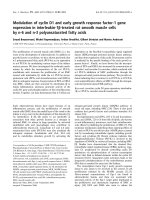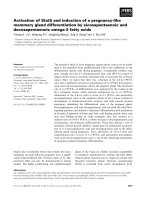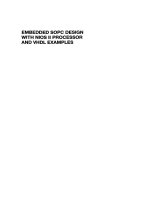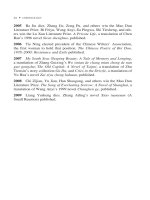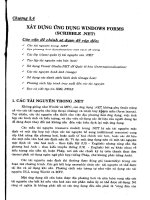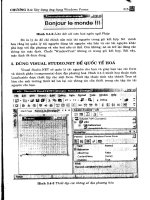FPGA prototyping by VHDL examples xilinx spartan 3 version 2008
Bạn đang xem bản rút gọn của tài liệu. Xem và tải ngay bản đầy đủ của tài liệu tại đây (17.36 MB, 458 trang )
FPGA PROTOTYPING
BY
VHDL
EXAMPLES
FPGA
PROTOTYPING
BY
VHDL
EXAMPLES
Xilinx SpartanTM-3 Version
Pong P.
Chu
Cleveland State University
WILEY-
INTERSCIENCE
A
JOHN
WILEY
&
SONS,
INC., PUBLICATION
Copyright
0
2008 by John Wiley
&
Sons,
Inc. All rights reserved.
Published by John Wiley
&
Sons,
Inc., Hoboken, New Jersey.
Published simultaneously in Canada.
No
part of this publication may be reproduced, stored in a retrieval system, or transmitted in any form or by
any means, electronic, mechanical, photocopying, recording, scanning, or otherwise, except as permitted under
Section 107 or 108 ofthe 1976 United States Copyright Act, without either the prior written permission ofthe
Publisher, or authorization through payment of the appropriate per-copy fee to the Copyright Clearance Center,
Inc., 222 Rosewood Drive, Danvers, MA 01923, (978) 750-8400, fax (978) 750-4470, or
on
the web at
www.copyright.com. Requests to the Publisher for permission should be addressed to the Permissions
Department, John Wiley
&
Sons,
Inc., 11 1 River Street, Hoboken, NJ 07030, (201) 748-601
1,
fax (201) 748-
6008, or online at
Limit of Liability/Disclaimer of Warranty: While the publisher and author have used their best efforts in
preparing this book, they make
no
representations or warranties with respect to the accuracy or completeness
of
the contents of this book and specifically disclaim any implied warranties of merchantability or fitness for a
particular purpose. No warranty may be created or extended by sales representatives or written sales materials.
The advice and strategies contained herein may not be suitable for your situation.
You
should consult with a
professional where appropriate. Neither the publisher nor author shall be liable for any
loss
of profit or any
other commercial damages, including but not limited to special, incidental, consequential, or other damages.
For general information
on
our other products and services or for technical support, please contact our
Customer Care Department within the United States at (800) 762-2974, outside the United States at (3 17) 572-
3993 or fax (317) 572-4002.
Wiley also publishes its books in a variety of electronic formats. Some content that appears in print may not be
available in electronic format. For information about Wiley products, visit
our
web site at www.wiley.com.
Library
of
Congress Cataloging-in-Publication Data:
Chu, Pong P., 1959-
p. cm.
FPGA prototyping by VHDL examples
/
Pong P.
Chu.
Includes bibliographical references and index.
ISBN 978-0-470-18531-5 (cloth
:
alk. paper)
1,
Field programmable gate arrays-Design and construction. 2. Prototypes,
Engineering. 3.VHDL (Computer hardware description language)
I.
Title.
TK7895.G36C485 2008
621.39'54~22 2007029063
Printed in the United States of America.
10987654321
To
myparents, Chia-Chi and Chi-Te, my wqe, Lee, and my daughtel; Patricia
CONTENTS
Preface
Acknowledgments
PART
I
BASIC DIGITAL CIRCUITS
1
Gate-level combinational circuit
1.1
1.2
1.3
1.4
1.5
1.6
Introduction
General description
1.2.1 Basic lexical rules
1.2.2 Library and package
1.2.3 Entity declaration
1.2.4 Data type and operators
1.2.5
Architecture body
1.2.6
Structural description
Testbench
Bibliographic notes
Suggested experiments
1.6.1
1.6.2
Code
of
a 2-bit comparator
Code for gate-level greater-than circuit
Code for gate-level binary decoder
2
Overview of
FPGA
and
EDA
software
xix
xxv
1
1
2
2
3
3
3
4
5
6
8
9
10
10
10
11
vii
viii
CONTENTS
2.1
2.2
2.3
2.4
2.5
2.6
2.7
2.8
2.9
Introduction
FPGA
2.2.1
2.2.2
Overview
of
the Digilent S3 board
Development flow
Overview of the Xilinx ISE project navigator
Short tutorial on ISE project navigator
2.6.1
2.6.2
2.6.3
2.6.4
Short tutorial on the ModelSim HDL simulator
Bibliographic notes
Suggested experiments
2.9.1
Gate-level greater-than circuit
2.9.2
Gate-level binary decoder
Overview
of
a general FPGA device
Overview
of the Xilinx Spartan-3 devices
Create the design project and HDL codes
Create a testbench and perform the RTL simulation
Add a constraint file and synthesize and implement the code
Generate and download the configuration file to an FPGA device
3
RT-level
combinational circuit
3.1
Introduction
3.2
RT-level components
3.2.1
Relational operators
3.2.2
Arithmetic operators
3.2.3
Other synthesis-related VHDL constructs
3.2.4
Summary
Routing circuit with concurrent assignment statements
3.3.1
Conditional signal assignment statement
3.3.2
Selected signal assignment statement
3.4.1
Process
3.4.2
Sequential signal assignment statement
Routing circuit with if and case statements
3.5.1
If statement
3.5.2
Case statement
3.5.3
Comparison to concurrent statements
3.5.4
Unintended memory
3.6
Constants and generics
3.6.1
Constants
3.6.2
Generics
3.7
Design examples
3.7.1
3.7.2
Sign-magnitude adder
3.3
3.4
Modeling with a process
3.5
Hexadecimal digit to seven-segment LED decoder
11
11
11
13
13
15
17
19
21
22
22
24
27
32
33
33
33
35
35
35
37
37
38
40
41
41
44
46
46
46
47
47
49
50
52
53
53
54
56
56
59
CONTENTS
ix
3.7.3
Barrel shifter
3.7.4
Simplified floating-point adder
3.8
Bibliographic notes
3.9
Suggested experiments
3.9.1
Multi-function barrel shifter
3.9.2
Dual-priority encoder
3.9.3
BCD incrementor
3.9.4
Floating-point greater-than circuit
3.9.5
3.9.6
Enhanced floating-point adder
Floating-point and signed integer conversion circuit
4
Regular Sequential Circuit
4.1
4.2
4.3
4.4
4.5
4.6
4.7
Introduction
4.1.1
D
FF
and register
4.1.2
Synchronous system
4.1.3
Code development
HDL code of the FF and register
4.2.1
DFF
4.2.2
Register
4.2.3
Register file
4.2.4
Simple design examples
4.3.1
Shift register
4.3.2
Binary counter and variant
Testbench for sequential circuits
Case study
4.5.1
LED time-multiplexing circuit
4.5.2
Stopwatch
4.5.3
FIFO buffer
Bibliographic notes
Suggested experiments
4.7.1
Programmable square wave generator
4.7.2
PWM and
LED
dimmer
4.7.3
Rotating square circuit
4.7.4
Heartbeat circuit
4.7.5
Rotating LED banner circuit
4.7.6
Enhanced stopwatch
4.7.7
Stack
Storage components in a Spartan-3 deviceXiLinx
specific
62
63
69
69
69
69
69
70
70
70
71
71
71
72
73
74
74
77
78
79
79
79
81
84
88
88
96
100
104
105
105
105
105
106
106
106
106
5
FSM
5.1
Introduction
107
107
X
CONTENTS
5.1.1
Mealy and Moore outputs
5.1.2
FSM representation
5.2
FSM code development
5.3
Design examples
5.3.1
Rising-edge detector
5.3.2
Debouncing circuit
5.3.3
Testing circuit
5.4
Bibliographic notes
5.5
Suggested experiments
5.5.1
Dual-edge detector
5.5.2
Alternative debouncing circuit
5.5.3
Parking lot occupancy counter
6
FSMD
6.1
Introduction
6.1.1
Single RT operation
6.1.2
ASMD chart
6.1.3
Code development of an FSMD
6.2.1
6.2.2
6.2.3
6.2.4
Comparison
6.2.5
Testing circuit
6.3.1
Fibonacci number circuit
6.3.2
Division circuit
6.3.3
Binary-to-BCD conversion circuit
6.3.4
Period counter
6.3.5
Accurate low-frequency counter
Decision box with a register
Debouncing circuit based on
RT
methodology
Code with explicit data path components
Code with implicit data path components
6.2
6.3
Design examples
6.4
Bibliographic notes
6.5
Suggested experiments
6.5.1
Alternative debouncing circuit
6.5.2
BCD-to-binary conversion circuit
6.5.3
6.5.4
6.5.5
Auto-scaled low -frequency counter
6.5.6
Reaction timer
6.5.7
Fibonacci circuit with BCD
IIO:
design approach
1
Fibonacci circuit with BCD
I/O:
design approach
2
Babbage difference engine emulation circuit
PART
II
I/OMODULES
107
108
111
114
114
118
122
124
124
124
124
125
127
127
127
128
129
131
132
134
136
137
138
140
1 40
143
147
150
153
156
157
157
157
157
157
158
158
159
CONTENTS
xi
7
UART
163
163
164
164
165
165
168
17 1
174
174
176
178
180
180
180
181
181
181
182
7.1
Introduction
7.2
UART receiving subsystem
7.2.1
Oversampling procedure
7.2.2
Baud rate generator
7.2.3
UART receiver
7.2.4
Interface circuit
7.3
UART transmitting subsystem
7.4
Overall UART system
7.4.1
Complete UART core
7.4.2
UART verification configuration
7.5
Customizing a UART
7.6
Bibliographic notes
7.7
Suggested experiments
7.7.1
Full-featured UART
7.7.2
7.7.3
7.7.4
UART-controlled stopwatch
7.7.5
UART-controlled rotating LED banner
UART with an automatic baud rate detection circuit
UART with an automatic baud rate and parity detection circuit
8
PS2
Keyboard
8.1
Introduction
8.2
PS2 receiving subsystem
8.2.1
Physical interface
of
a
PS2
port
8.2.2
Device-to-host communication protocol
8.2.3
Design and code
8.3
PS2 keyboard scan code
8.3.1
Overview
of
the scan code
8.3.2
Scan code monitor circuit
8.4.1
8.4.2
Verification circuit
8.4 PS2
keyboard interface circuit
Basic design and HDL code
8.5
Bibliographic notes
8.6
Suggested experiments
8.6.1
Alternative keyboard interface
I
8.6.2
Alternative keyboard interface
I1
8.6.3
8.6.4
Keyboard-controlled stopwatch
8.6.5
Keyboard-controlled rotating LED banner
PS2
receiving subsystem with watchdog timer
183
183
184
184
184
184
188
188
189
191
192
194
196
196
196
196
197
197
197
9
PS2Mouse
199
xii
CONTENTS
9.1
Introduction
9.2 PS2
mouse protocol
9.2.1
Basic operation
9.2.2
Basic initialization procedure
9.3 PS2
transmitting subsystem
9.3.1
Host-to-PS2-device communication protocol
9.3.2
Design and code
9.4
Bidirectional
PS2
interface
9.4.1
Basic design and code
9.4.2
Verification circuit
9.5 PS2
mouse interface
9.5.1
Basic design
9.5.2
Testing circuit
9.6
Bibliographic notes
9.7
Suggested experiments
9.7.1
Keyboard control circuit
9.7.2
Enhanced mouse interface
9.7.3
Mouse-controlled seven-segment
LED
display
10
External SRAM
10.1
Introduction
10.2
Specification
of
the
IS61LV25616AL
SRAM
10.2.1
Block diagram and
110
signals
10.2.2
Timing parameters
10.3.1
Block diagram
10.3.2
Timing requirement
10.3.3
Register file versus SRAM
10.4.1
ASMD chart
10.4.2
Timing analysis
10.4.3
HDL
implementation
10.4.4
Basic testing circuit
10.4.5
Comprehensive SRAM testing circuit
10.5.1
Timing issues
10.5.2
Alternative design
I
10.5.3
Alternative design I1
10.5.4
Alternative design I11
10.5.5
Advanced
FPGA
featuresxizinx
specific
10.3
Basic memory controller
10.4
A safe design
10.5
More aggressive design
10.6
Bibliographic notes
10.7
Suggested experiments
199
200
200
200
20
1
20 1
202
206
206
208
210
210
212
214
214
214
214
214
21
5
215
216
216
216
220
220
22 1
222
222
222
223
224
226
228
233
233
234
236
237
237
240
240
CONTENTS
xiii
10.7.1 Memory with a 512K-by-16 configuration
10.7.2 Memory with a 1M-by-8 configuration
10.7.3 Memory with an 8M-by-1 configuration
10.7.4 Expanded memory testing circuit
10.7.5 Memory controller and testing circuit for alternative design I
10.7.6 Memory controller and testing circuit for alternative design I1
10.7.7
Memory controller and testing circuit for alternative design
III
10.7.8 Memory controller with DCM
10.7.9 High-performance memory controller
11 Xilinx Spartan-3 Specific Memory
1 1.1 Introduction
1
1.2 Embedded memory of Spartan-3 device
1
1.2.1 Overview
11.2.2 Comparison
11.3 Method to incorporate memory modules
11.3.1 Memory module via HDL component instantiation
11.3.2 Memory module via Core Generator
1 1.3.3 Memory module via HDL inference
1
I
.4
HDL templates for memory inference
1 1.4.1 Single-port RAM
1 1.4.2 Dual-port RAM
11.4.3 ROM
11.5 Bibliographic notes
11.6 Suggested experiments
1 1.6.1 Block-RAM-based
FIFO
11.6.2 Block-RAM-based stack
11.6.3 ROM-based sign-magnitude adder
11.6.4 ROM based
sin(%)
function
11.6.5 ROM-based
sin(%)
and
cos(5)
functions
12
VGA
controller
I:
graphic
12.1 Introduction
12.1.1 Basic operation of a CRT
12.1.2 VGA port of the S3 board
12.1.3 Video controller
12.2 VGA synchronization
12.2.1 Horizontal synchronization
12.2.2 Vertical synchronization
12.2.3 Timing calculation of VGA synchronization signals
12.2.4 HDL implementation
240
240
240
24 1
24 1
24 1
24
1
24
1
24 1
243
243
243
243
244
244
245
245
246
246
246
249
25 1
254
254
254
254
255
255
255
257
257
257
259
259
260
260
262
263
263
XiV
CONTENTS
12.2.5
Testing circuit
12.3
Overview
of
the pixel generation circuit
12.4
Graphic generation with
an
object-mapped scheme
12.4.1
Rectangular objects
12.4.2
Non-rectangular object
12.4.3
Animated object
12.5
Graphic generation with
a
bit-mapped scheme
12.5.1
Dual-port RAM implementation
12.5.2
Single-port RAM implementation
12.6
Bibliographic notes
12.7
Suggested experiments
12.7.1
VGA test pattern generator
12.7.2
SVGA mode synchronization circuit
12.7.3
Visible screen adjustment circuit
12.7.4
Ball-in-a-box circuit
12.7.5
Two-balls-in-a-box circuit
12.7.6
Two-player pong game
12.7.7
Breakout game
12.7.8
Full-screen dot trace
12.7.9
Mouse pointer circuit
12.7.10
Small-screen mouse scribble circuit
12.7.11
Full-screen mouse scribble circuit
13
VGA
controller
II:
text
13.1
Introduction
13.2
Text generation
13.2.1
Character as a tile
13.2.2
Font ROM
13.2.3
Basic text generation circuit
13.2.4
Font display circuit
13.2.5
Font scaling
13.3
Full-screen text display
13.4
The complete pong game
13.4.1
Text subsystem
13.4.2
Modified graphic subsystem
13.4.3
Auxiliary counters
13.4.4
Top-level system
13.5
Bibliographic notes
13.6
Suggested experiments
13.6.1
Rotating banner
13.6.2
Underline for the cursor
13.6.3
Dual-mode text display
266
267
268
269
273
275
282
282
287
287
287
287
288
288
288
289
289
289
289
290
290
290
291
29 1
29 1
29
1
292
294
295
297
298
302
302
309
310
312
317
317
317
317
317
CONTENTS
XV
13.6.4 Keyboard text entry
13.6.5 UART terminal
13.6.6 Square wave display
13.6.7 Simple four-trace logic analyzer
13.6.8 Complete two-player pong game
13.6.9 Complete breakout game
PART
111
PICOBLAZE
MICRO CONTROLLER^^^^^^
14
PicoBlaze Overview
14.1 Introduction
14.2 Customized hardware and customized software
14.2.1 From special-purpose FSMD to general-purpose microcontroller
14.2.2 Application of microcontroller
14.3.1 Basic organization
14.3.2 Top-level
HDL
modules
14.3 Overview of PicoBlaze
14.4 Development flow
14.5 Instruction set
14.5.1 Programming model
14.5.2 Instruction format
14.5.3 Logical instructions
14.5.4 Arithmetic instructions
14.5.5 Compare and test instructions
14.5.6 Shift and rotate instructions
14.5.7 Data movement instructions
14.5.8 Program flow control instructions
14.5.9 Interrupt related instructions
14.6.1 The KCPSM3 directives
14.6.2 The PBlazeIDE directives
14.6 Assembler directives
14.7 Bibliographic notes
15
PicoBlaze Assembly Code Development
15.1 Introduction
15.2 Useful code segments
15.2.1 KCPSM3 conventions
15.2.2 Bit manipulation
15.2.3 Multiple-byte manipulation
15.2.4 Control structure
15.3 Subroutine development
15.4 Program development
317
3 17
318
318
3 19
319
323
323
324
324
326
326
326
328
329
329
33 1
332
332
333
334
335
336
338
341
342
342
342
343
345
345
345
345
346
347
348
350
35 1
XVi
CONTENTS
15.4.1
Demonstration example
15.4.2
Program documentation
15.5
Processing
of
the assembly code
15.5.1
Compiling with
KCSPM3
15.5.2
Simulation by PBlazeIDE
15.5.3
Reloading code via the
JTAG
port
15.5.4
Compiling by PBlazeIDE
15.6
Syntheses with PicoBlaze
15.7
Bibliographic notes
15.8
Suggested experiments
15.8.1
Signed multiplication
15.8.2
Multi-byte multiplication
15.8.3
Barrel shift function
15.8.4
Reverse function
15.8.5
Binary -to-BCD conversion
15.8.6
BCD-to-binary conversion
15.8.7
Heartbeat circuit
15.8.8
Rotating LED circuit
15.8.9
Discrete LED dimmer
16
PicoBlaze
110
Interface
16.1
Introduction
16.2
Output port
16.2.1
Output instruction and timing
16.2.2
Output interface
16.3.1
Input instruction and timing
16.3.2
Input interface
16.4
Square program with a switch and seven-segment LED display interface
16.4.1
Output interface
16.4.2
Input interface
16.4.3
Assembly code development
16.4.4
VHDL code development
16.5
Square program with a combinational multiplier and UART console
16.5.1
Multiplier interface
16.5.2
UART interface
16.5.3
Assembly code development
16.5.4
VHDL code development
16.3
Input
port
16.6
Bibliographic notes
16.7
Suggested experiments
16.7.1
Low-frequency counter
I
16.7.2
Low-frequency counter
11
352
356
358
358
359
362
362
363
3 64
365
365
365
365
365
365
365
365
366
366
367
367
368
368
3 69
37 1
37 1
37 1
373
374
375
376
384
386
387
387
389
398
402
402
402
402
CONTENTS
xvii
16.7.3
Auto-scaled low-frequency counter
16.7.4
Basic reaction timer with a software timer
16.7.5
Basic reaction timer with a hardware timer
16.7.6
Enhanced reaction timer
16.7.7
Small-screen mouse scribble circuit
16.7.8
Full-screen mouse scribble circuit
16.7.9
Enhanced rotating banner
16.7.10
Pong game
16.7.1
1
Text editor
17
PicoBlaze Interrupt Interface
17.1
Introduction
17.2
Interrupt handling in PicoBlaze
17.2.1
Software processing
17.2.2
Timing
17.3.1
Single interrupt request
17.3.2
Multiple interrupt requests
17.4
Software development considerations
17.4.1
Interrupt as an alternative scheduling scheme
17.4.2
Development of an interrupt service routine
17.5.1
Interrupt interface
17.5.2
Interrupt service routine development
17.5.3
Assembly code development
17.5.4
VHDL code development
17.3
External interface
17.5
Design example
17.6
Bibliographic notes
17.7
Suggested experiments
17.7.1
Alternative timer interrupt service routine
17.7.2
Programmable timer
17.7.3
Set-button interrupt service routine
17.7.4
Interrupt interface with two requests
17.7.5
Four-request interrupt controller
Appendix A: Sample
VHDL
templates
A.
1
General VHDL constructs
A. 1.1
Overall code structure
A.
1.2
Component instantiation
A.2.1
Arithmetic operations
A.2.2
Fixed-amount shift operations
A.2
Combinational circuits
402
403
403
403
403
403
403
404
404
405
405
405
406
407
408
408
408
409
409
410
410
410
41 1
41 1
413
417
417
417
417
417
417
418
41 9
419
419
420
42 1
42 1
422
XViii
CONTENTS
A.2.3
Routing with concurrent statements
A.2.4
Routing with if and case statements
A.2.5
Combinational circuit using process
A.3.1
Register template
A.3.2
Register file
A.4
Regular sequential circuits
AS FSM
A.6 FSMD
A.7
A.3
Memory Components
S3
board constraint file
(s3.
ucf)
References
422
423
424
425
425
426
427
428
430
433
437
Topic Index
439
PREFACE
HDL
(hardware description language) and
FPGA
(field-programmable gate array) devices
allow designers to quickly develop and simulate a sophisticated digital circuit, realize it
on a prototyping device, and verify operation of the physical implementation. As these
technologies mature, they have become mainstream practice. We can now use a
PC
and
an inexpensive FPGA prototyping board to construct a complex and sophisticated digital
system. This book uses a “learning by doing” approach and illustrates the FPGA and
HDL
development and design process by a series of examples. A wide range of examples is
included, from a simple gate-level circuit to an embedded system with an 8-bit soft-core
microcontroller and customized
I/O
peripherals. All examples can be synthesized and
physically tested on a prototyping board.
Focus and audience
FOCUS
The main focus
of
this book is on the effective derivation of hardware, not the
syntax of HDL. Instead of explaining every language construct, the book is limited to a
small synthesizable subset and uses about a dozen code templates to provide the skeletons
of various types of circuits. These templates are general and can easily be integrated to
construct a large, complex system. Although this approach limits the “freedom” of syntactic
expression, it will not prevent us from developing innovative hardware architecture. Because
of the generality and flexibility of HDL, the same circuit can usually be described by a
wide variety of language constructs and coding styles. Many of these codes are intended
for modeling. They may lead to unnecessarily complex hardware implementation and
sometimes cannot be synthesized at all. The template approach actually forces us to think
more about hardware and develop a good coding practice for synthesis. Since we are
xix
XX
PREFACE
more interested in hardware,
it
is more beneficial to spend time on developing
10
different
hardware architectures with the same code template rather than describing the same circuit
with
10
different versions of codes.
There are two popular HDLs,
VHDL
and
Verilog.
Both languages are used widely and
are IEEE standards. This book uses VHDL, and a separate book with a similar title uses
Verilog. Despite the drastic syntactic differences
in
the two languages, their capabilities are
very similar, particularly for our purposes. After we comprehend the design practice and
coding methodology in one language, learning the other language is rather straightforward.
Although the book is intended for beginning designers, the examples follow strict design
guidelines and prepare readers for future endeavors. The coding and design practice is
“forward compatible,” which means that:
0
The same practice can be applied to large design in the future.
0
The same practice can aid other system development tasks, including simulation,
0
The same practice can be applied to ASIC technology and different types of FPGA
0
The code can be accepted by synthesis software from different vendors.
In summary, the book is a hands-on, hardware-centric text that involves
minimal HDL
overhead
and follows good design and coding practice to achieve
maximal forward
com-
parability.
timing analysis, verification, and testing.
devices.
Audience and perquisites
The book contains three major parts: basic digital circuits,
peripheral modules, and embedded microcontroller. The intended audience is students in
an introductory or advanced digital system design course as well as practicing engineers
who wish to learn FPGA- and HDL-based development. For the materials in the first two
parts, readers need to have a basic knowledge of digital systems, usually a required course
in electrical engineering and computer engineering curricula. For the materials in the third
part, prior exposure to assembly language programming will be helpful.
Logistics
Although a major goal of this book is to teach readers to develop software-independent
and device-neutral HDL codes, we have to choose a software package and a prototyping
board to synthesize and implement the design examples. The synthesis software and FPGA
devices from Xilinx, a leading manufacture in this area, are used in the book.
Software
The synthesis software used in the book is the Web version of the Xilinx
ZSE
package. The functionality is of this version is similar to that of the full version but
supports only a limited number of devices. Most introductory development boards use
FPGA devices from the inexpensive Spartan-3 family. Since the Web version supports
the Spartan-3 device, it fits our need. The simulation software used in the book is the
starter version of Mentor Graphics’
ModelSim
XE
III
package. It is a customized edition
of
ModelSim.
Both software packages are free and can be downloaded from Xilinx’s Web
site.
FPGA prototyping board
This book is prepared to be used with several entry-level
FPGA prototyping boards manufactured by Digilent Inc., including the
Spartan-3 Starter,
Nexys-2,
and
Basys
boards, all of which contain a Spartan-3/3E FPGA device and have
PREFACE
xxi
similar
I/O
peripherals. The design examples in the book are based on the Spartan-3 Starter
board (or simply the
S3
board),
but most of them can be used directly in other boards as
well. The applicability of the HDL codes is summarized below.
0
Spartan-3 Starter 3
(S3)
board.
The S3 board contains all the peripherals and
no additional accessory module is needed. All HDL codes and discussions can be
applied to this board directly.
0
Nexys-2
board.
The Nexys-2 board is a newer board, which contains a larger FPGA
device and a larger memory chip.
Its peripherals are similar to those in the S3
board. There are two differences. First, the “color depth” of its VGA interface is
expanded from 3 bits to
8
bits. The the output of the VGA interface circuits discussed
in Chapters 12 and 13 needs to be modified accordingly. Second, it contains a
more sophisticated external memory device. Although the device can be configured
as an asynchronous SRAM, the timing characteristics is different from that
of
the
S3 board’s memory device, and thus the HDL codes for the memory controller in
Chapter
10
cannot be used directly. However, the same design principle can be
applied to construct a new controller.
0
Basys board.
The Basys board is a simpler board. It lacks the RS-232 connector.
To implement the UART module and the serial interface discussed in Chapter
7,
we
need Digilent’s
RS-232
converterperipheral module.
The Basys board has no external
memory devices, and thus the discussion of the memory controller in Chapter
10
is
not applicable.
0
Other
FPGA
boards.
Most peripherals discussed in this book are de facto industrial
standards, and the corresponding HDL codes can be used as long as a board provides
proper analog interface circuits and connectors. Except for the Xilinx-specific por-
tions, the codes can be applied to the boards based on the FPGA devices from other
manufacturers as well.
PC
Accessories
The design examples include interfaces to several PC peripheral de-
vices. A keyboard, a mouse, and a VGA monitor are required for the respective modules,
and a “straight-through’’ serial cable (the most commonly used type) is required for the
UART module. These accessories are widely available and can probably be obtained from
an old PC.
Book
organization
The book is divided into three major parts. Part
I
introduces the elementary HDL constructs
and their hardware counterparts, and demonstrates the construction of a basic digital circuit
with these constructs. It consists of six chapters:
0
Chapter 1 describes the skeleton of an HDL program, basic language syntax, and
logical operators. Gate-level combinational circuits are derived with these language
constructs.
0
Chapter 2 provides an overview of an FPGA device, prototyping board, and devel-
opment flow. The development process is demonstrated by a tutorial on Xilinx
ISE
synthesis software and a tutorial on Mentor Graphics ModelSim simulation software.
0
Chapter 3 introduces HDL‘s relational and arithmetic operators and routing constructs.
These correspond to medium-sized components, such as comparators, adders, and
multiplexers. Module-level combinational circuits are derived with these language
constructs.
xxii
PREFACE
0
Chapter
4
covers the codes for memory elements and the construction of “regular”
sequential circuits, such as counters and shift registers, in which the state transitions
exhibit a regular pattern.
0
Chapter
5
discusses the construction of a finite state machine (FSM), which is a
sequential circuit whose state transitions do not exhibit a simple, regular pattern.
0
Chapter 6 presents the construction of an
FSM
with data path (FSMD). The FSMD is
used to implement register transfer (RT) methodology, in which the system operation
is described by data transfers and manipulations among registers.
Part I1 applies the techniques from Part
I
to design an array of peripheral modules for the
prototyping board. Each chapter covers the development, implementation, and verification
of an individual peripheral. These modules can be incorporated to a larger project. Part I1
consists of seven chapters:
0
Chapter 7 discusses the design of a universal asynchronous receiver and transmitter
(UART), which provides a serial link to receive and transmit data via the prototyping
0
Chapter
8
covers the design of a keyboard interface, which reads scan code from a
keyboard. The keyboard is connected via the prototyping board’s PS2 port.
0
Chapter
9
covers the design of a mouse interface, which obtains the button and move-
ment information from a mouse. The mouse is also connected via the prototyping
board’s PS2 port.
0
Chapter 10 discusses the implementation and timing issues of a memory controller.
The controller is used to read data from and write data to the two static random access
memory (SRAM) devices on the S3 board.
0
Chapter 11 discusses the inference and application
of
Spartan-3 device-specific com-
ponents. The focus is on the
FF’GA’s
internal memory blocks and the digital clock
management (DCM) circuit.
0
Chapter 12 presents the design and implementation of a video controller. The discus-
sion covers the generation of video synchronization signals and shows the construc-
tion of simple bit- and object-mapped graphical interface. The monitor is connected
to the prototyping board’s VGA port.
0
Chapter 13 continues development
of
the video controller. The discussion illustrates
the construction of text interface and general tile-mapped scheme.
Part I11 introduces an FPGA-based soft-core microcontroller, known as
PicoBlaze,
and
demonstrates the integration
of
a general-purpose processor and customized circuit. It
includes four chapters:
0
Chapter
14
provides an overview of the organization and instruction set of PicoBlaze.
0
Chapter 15 introduces the basic assembly programming and provides an overview of
0
Chapter 16 discusses PicoBlaze’s I/O feature and illustrates the procedure to derive
0
Chapter 17 discusses PicoBlaze’s interrupt capability and demonstrates the construc-
In addition to regular chapters, the appendix summarizes and lists all code templates.
board’s RS-232 port.
the development process.
customized circuits to interface other I/O peripherals.
tion of a customized interrupt-handling circuit.
Special
mark#i1inx
8pecif
ic
While the examples of this book are implemented on a
Xilinx-based prototyping board and the codes are synthesized by Xilinx ISE software, we
try to make the HDL codes device-independent and software-neutral as much as possible.
Most discussions and codes can be applied to different target devices and different synthesis
PREFACE
xxiii
software as well. However, certain codes or device features are unique to Xilinx ISE
software or Spartan-3 FPGA devices. We use the
Xilinx
spec@c
superscript, as in the
heading of this section, to indicate that the discussion in the corresponding section or
chapter is unique to Xilinx.
Similarly, we use marginal notes, such as the one shown on the outer edge, to indicate
that the discussion in the paragraph is unique to Xilinx. This note indicates that the code
Xilinx
or design is no longer portable and needs to be revised when a different software package
specific
or target device is used.
Instructional use
The book can be a good companion text for an introductory digital systems course or
an advanced project-oriented course. In an introductory digital systems course, the book
supplies the lab portion of the curriculum. The chapters
in
Part
I
basically follow the
sequence of a typical curriculum and can be presented along with regular lectures. One or
two peripheral modules can be selected as case studies, and corresponding experiments can
be used as term projects.
In an advanced project-oriented course, the book provides a base for independent projects.
The materials in Part
I
should be treated as an overview or refresher, which provides a general
background on HDL, synthesis, and FPGA boards. Some modules in Part I1 can be used to
demonstrate the design of more complex circuits. These modules can also be considered as
building blocks (i.e., IPS) or subsystems to be integrated into final projects. The PicoBlaze
microcontroller in Part I11 can be used as general-purpose processor if an embedded-system
type of project is desired.
Companion Web site
An accompanying Web site
(http
:
//academic. csuohio
.
edu/chu-p/rtl)
provides addi-
tional information, including the following materials:
0
Errata
0
Code templates
0
HDL code listing and relevant files
0
Links to synthesis and simulation software
0
Links to referenced materials
0
Additional project ideas
Errata
The
book
is self-prepared, which means that the author has produced all aspects
of the text, including illustrations, tables, code listings, indexing, and formatting. As errors
are always bound to happen, the accompanying Web site provides an updated errata sheet
and a place to report errors.
Cleveland,
Ohio
October
2007
ACKNOWLEDGMENTS
The author would like to express his gratitude to Professor George
L.
Kramerich for his
encouragement and help.
The author also thanks John Wiley
&
Sons, Inc. for giving permission to use Figures 3.1,
3.2,
4.2,
4.10, 4.11, and
6.5
from my text
RTL Hardware Design Using VHDL: Coding
for EfJiciency, Portability, and Scalability,
and Xilinx, Inc. for giving permission to use
Figures 2.3 and 8.3 from the
Spartan-3 Starter Kit Board User Guide.
All trademarks used or referred to in this book
are
the property
of
their respective owners.
P. P.
Chu
xxv
PART
I
BASIC DIGITAL CIRCUITS
CHAPTER
1
GATE-LEVEL COMBINATIONAL CIRCUIT
1.1
INTRODUCTION
VHDL stands for “VHSIC (very high-speed integrated circuit) hardware description lan-
guage.” It was originally sponsored by the
U.S.
Department of Defense and later transferred
to the IEEE (Institute of Electrical and Electronics Engineers). The language is formally de-
fined by IEEE Standard
1076.
The standard was ratified in
1987
(referred to as VHDL
87),
and revised several times. This book mainly follows the revision in 1993 (referred to as
VHDL
93).
VHDL is intended for describing and modeling a digital system at various levels and
is an extremely complex language. The focus of this book is on hardware design rather
than the language. Instead of covering every aspect of VHDL, we introduce the key VHDL
synthesis constructs by examining a collection of examples. Detailed VHDL coverage may
be explored through the sources listed in the Bibliography.
In this chapter, we use a simple comparator to illustrate the skeleton
of
a VHDL pro-
gram. The description uses only logical operators and represents a gate-level combinational
circuit, which is composed of simple logic gates. In Chapter 3, we cover the more sophis-
ticated VHDL operators and constructs and examine module-level combinational circuits,
which are composed of intermediate-sized components, such as adders, comparators, and
multiplexers.
FPGA Prototyping
by
VHDL
Examples.
By
Pong
P.
Chu
Copyright
@
2008
John
Wiley
&
Sons,
Inc.
1
